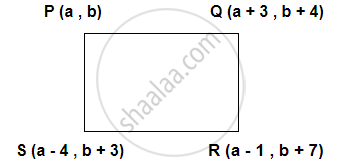Advertisements
Advertisements
प्रश्न
Prove that the points (a, b), (a + 3, b + 4), (a − 1, b + 7) and (a − 4, b + 3) are the vertices of a parallelogram.
उत्तर

PQ = `sqrt (("a" + 3 - "a")^2 + ("b" + 4 - "b")^2) = sqrt (9 + 16) = 5` units
QR = `sqrt (("a" + 3 - "a" + 1)^2 + ("b" - 4 - "b" - 7)^2) = sqrt (16 + 9) = 5` units
RS = `sqrt (("a" -1 - "a" + 4)^2 + ("b" + 7 - "b" - 3)^2) = sqrt (9 + 16) = 5` units
SP = `sqrt (("a" - 4 - "a")^2 + ("b" + 3 - "b")^2) = sqrt (16 + 9) = 5` units
Since the opposite sides of quadrilateral PQRS are equal, therefore it is a parallelogram.
APPEARS IN
संबंधित प्रश्न
Name the type of quadrilateral formed, if any, by the following point, and give reasons for your answer:
(−3, 5), (3, 1), (0, 3), (−1, −4)
Find the distance between the following pair of points:
(-6, 7) and (-1, -5)
Find the distance between the following pair of points.
L(5, –8), M(–7, –3)
The perimeter of a triangle with vertices (0, 4), (0, 0) and (3, 0) is ______.
x (1,2),Y (3, -4) and z (5,-6) are the vertices of a triangle . Find the circumcentre and the circumradius of the triangle.
PQR is an isosceles triangle . If two of its vertices are P (2 , 0) and Q (2 , 5) , find the coordinates of R if the length of each of the two equal sides is 3.
The distance between the points (3, 1) and (0, x) is 5. Find x.
If the point (x, y) is at equidistant from the point (a + b, b – a) and (a-b, a + b). Prove that ay = bx.
Show that the point (11, – 2) is equidistant from (4, – 3) and (6, 3)
The distance of the point (5, 0) from the origin is ______.
